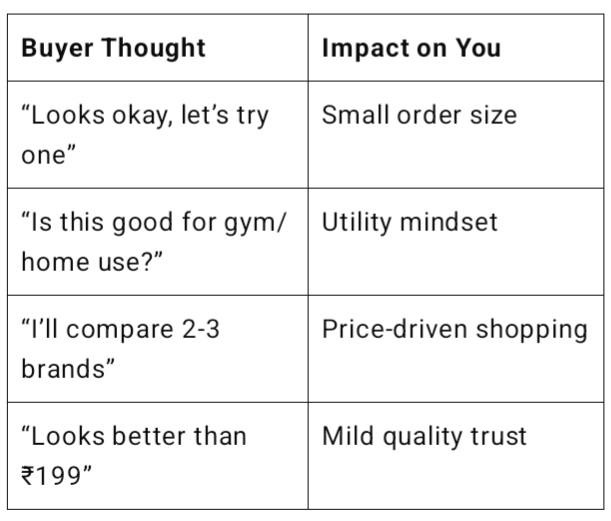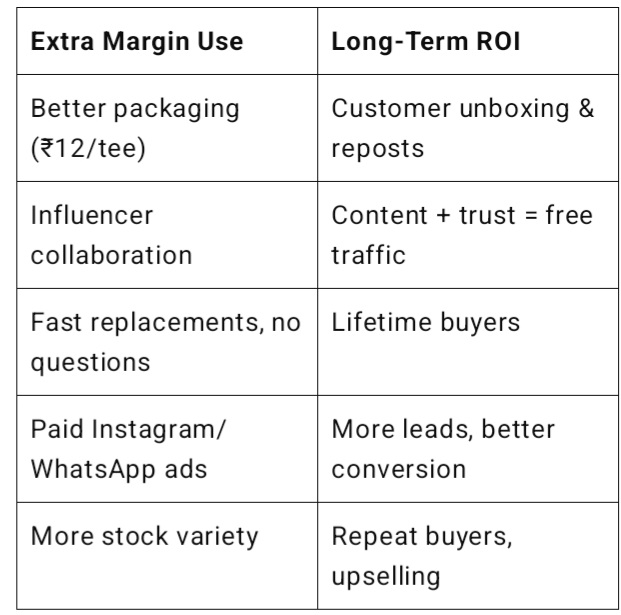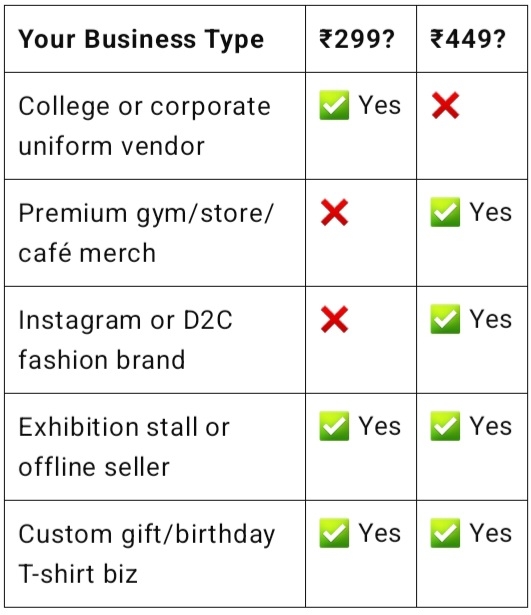🧠 Why This Blog Is a Game-Changer
Most resellers think higher prices reduce orders. In reality, it’s low prices that shrink your business over time.
Here’s what we’ll decode:
• The buyer psychology behind ₹299 and ₹449
• Why ₹449 pricing builds brands faster
• How to create premium feel without premium costs
• Cumulative profit comparisons nobody talks about
• Real stories of businesses scaling with ₹449 pricing
1. What ₹299 Pricing Says to Your Customer
₹299 says:
“Decent quality, fair price. Let’s try it.”
When you sell T-shirts at ₹299, buyers usually think:
“Looks okay, let me try one.” This often leads to smaller orders.
“Maybe this is good for gym or home use,” meaning they see it as a utility product.
They tend to compare your product with 2–3 other sellers, mainly on price.
Still, it feels like a better option than the super-cheap ₹199 tees, so they may give it a shot.
Here’s what that means practically:

You’ll get average conversions, moderate loyalty, but price-based objections often.
Still, it’s a good entry point for:
• Budget fashion buyers
• Gift shops
• Local startups testing waters
But here’s where it flips…
2. 💡 What ₹449 Pricing Triggers: Brand Respect and Margin Power
When your tee is ₹449, you’re no longer compared to “cheap”.
The buyer thinks:
“It looks like a brand.”
“Must be quality fabric.”
“I can post this on Instagram.”
“Maybe it’s oversized or rare print.”
They feel it looks premium and are more willing to pay.
They ask if they can buy 5 or more with the same design — great for bulk B2C sales.
Many say, “This is perfect for my brand,” which brings in repeat business and brand partnerships.
Here’s what that price communicates:

3. Real Profit Difference: ₹299 vs ₹449
Let’s assume 1,000 T-shirts/month.
At ₹299, you make around ₹60 to ₹80 profit per t-shirt.
If you sell 1,000 pieces/month, that’s ₹60,000 to ₹80,000 monthly, or ₹7.2 to ₹9.6 lakh/year.
At ₹449, your profit jumps to ₹130 to ₹170 per piece.
The same 1,000 monthly sales now give you ₹1.3 to ₹1.7 lakh/month, or ₹15.6 to ₹20.4 lakh/year.

That’s ₹10–₹13 lakh extra annually, with the same order quantity.
4. Where the Extra ₹150 Margin Actually Goes
This is why high-ticket pricing is not just about margin:
That extra ₹150 you earn per T-shirt at a ₹449 price point isn’t just profit — it’s power.
Here’s how smart sellers use it:
Spend ₹12 per piece on better packaging → Customers love the unboxing and may even post it online.
Pay influencers or micro-creators once or twice → Their content drives organic reach and trust.
Offer no-questions-asked replacements → Builds loyalty and long-term repeat buyers.
Run paid ads on Instagram or WhatsApp → Now you can afford marketing that actually converts.
Invest in more variety and faster restocking → More SKUs = more upsells = more revenue.

Want to make sure you’re buying smart from the start? Click here 👉 how smart apparel brands cut costs by choosing the right wholesale t-shirt partner.
5. Who Should Sell at ₹299 vs ₹449?
Let’s be practical. Not every T-shirt needs to be ₹449.
Here’s who should go for ₹299 pricing:
College uniform suppliers
Corporate bulk gifting vendors
Event merch resellers
→ These customers focus on quantity and budget. Quality can be decent, but price is key.
Here’s who should go for ₹449+ pricing:
Instagram D2C clothing brands
Premium gym, café, or lifestyle brands
Creators and personal brands selling their own merch
→ These businesses rely on brand image, repeat orders, and perceived value.

If your brand identity matters — go ₹449.
6. 🚀 Business Scenarios with ₹449 Pricing in Action
👕 Streetwear Brand
Product: Oversized 220 GSM tee, minimal branding
Cost: ₹165
Selling Price: ₹449
Profit: ₹284 x 500 = ₹1.42 lakh
Monthly revenue = ₹2.25 lakh+
Result: Customer base exploded through UGC photos on Instagram.
💼 Startup Merchandise Seller
Product: 180 GSM printed tees for startup founders
Cost: ₹145 (with HD print)
Selling: ₹399–₹449
Volume: 100 tees per client
Profit: ₹25,000–₹30,000 per order
Result: Gained 5 startup clients via LinkedIn DM.
7. 🎁 How to Look Like ₹599 and Sell at ₹449
To justify ₹449 and still feel premium:
Use custom woven neck labels (adds ₹5, looks like ₹50)
Send in a ziplock or recycled box (adds ₹8, looks like ₹80)
Include a branded thank-you card
Add a story tag: “100% combed cotton | Ethically Made”
Film a BTS reel: fabric cutting, tagging, printing
💡 At Radison Apparel, we offer all of this at no minimum quantity and wholesale rates.
Final Thought: The ₹449 Price Tag Isn’t Costly—It’s Strategic
If you’re tired of playing the low-price game, then:
Start pricing for the customer you want
Create a brand feel that demands respect
Use premium pricing to cover your growth costs
Radison Apparel gives you:
✅ 160–220 GSM custom T-shirts
✅ HD printing & embroidery
✅ Neck label + tag branding
✅ No MOQ + bulk discounts
✅ Custom support for your brand journey
📞 Start Selling Premium, Not Cheap
Whether you want to test ₹299 or launch at ₹449—we’ll help you get there with the right GSM, designs, and branding tools.
👉 Contact Now
📲 +91-9043267615
sales@radisonapparel.com


Pingback: How Startups and Small Brands Can Launch a Clothing Line with Just 50 T-Shirts - radisonapparel.com